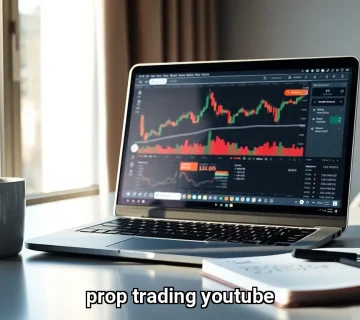What’s prop trading? In the fast-paced world of finance, prop trading stands out as a fascinating strategy that can generate significant profits for firms willing to take calculated risks. This approach involves financial institutions, like Propx Pro, using their own capital to engage in trading activities, aiming to capitalize on market opportunities without the constraints typical of traditional brokerage services. Unlike brokers who earn commissions from clients, prop traders dive directly into the market, leveraging their resources to seek out profit-generating ventures. With firms like Propx Pro providing traders access to substantial capital and cutting-edge trading technologies, the opportunities for success in prop trading are substantial, though they come with significant risks.
As we explore the ins and outs of proprietary trading, we will uncover the various strategies employed by firms, the types of instruments traded, and the advantages that come with this bold method of trading. Whether you’re a budding investor or a seasoned trader, understanding the mechanics of prop trading can offer valuable insights into how financial markets operate. Join us as we delve deeper into this dynamic realm, examining the techniques that define successful trading desks and the evolving landscape of proprietary trading. Your journey into the world of what’s prop trading starts here!
Understanding Prop Trading
Proprietary trading, commonly referred to as prop trading, involves firms using their own capital to trade with the aim of generating profits directly for themselves. Unlike traditional brokerage practices, which rely on commissions from client transactions, prop trading allows firms to act independently, capitalizing on market opportunities without external constraints. This self-directed approach enables firms to engage in diverse activities like stocks, bonds, currencies, and derivatives. For example, Propx Pro is a firm that empowers traders with access to significant capital and advanced trading tools, enabling them to capitalize on market opportunities with greater flexibility. Through prop trading, firms like Propx Pro foster innovation and adaptability, employing strategies that may be considered too risky for traditional brokers.

The Basics of Prop Trading
To grasp the essence of what’s prop trading, it’s essential to understand the operational framework within which these trades are executed. Proprietary trading desks are typically segregated from client-focused trading desks to ensure that client interests do not interfere with the pursuit of profit through proprietary means. This separation enables prop traders to make decisions based solely on market data and their interpretation of potential opportunities, without the pressure of client expectations or risk aversion. The freedom to operate in this manner fosters a highly competitive environment within prop trading firms, where traders are encouraged to innovate and refine their strategies continuously.
The types of instruments traded in prop trading can vary, but they often include equities, options, futures, and foreign exchange. By engaging in these diverse trading avenues, firms can construct a portfolio that balances risk and reward according to their strategic objectives. For example, when a firm engages in proprietary trading, it utilizes advanced analytics and market data to guide its decisions, positioning itself to respond swiftly to emerging trends and price movements. This agility can differentiate successful firms in the competitive trading landscape, as they can seize opportunities that arise from market volatility or inefficiencies.
Furthermore, the ability to use their own capital means that firms can pursue speculative strategies that might not be viable if they were reliant on client funds, which often come with specific risk parameters and investment goals. Firms like Propx Pro offer traders access to advanced tools and capital to help them navigate this dynamic environment and take advantage of such opportunities with greater flexibility.
Exploring Prop Trading Strategies
The strategies employed in proprietary trading are as varied as the financial instruments available. Among the most common techniques are index arbitrage and statistical arbitrage, which rely on mathematical models and statistical analyses to identify mispricings in the market. These strategies often require high-frequency trading capabilities to capitalize on fleeting opportunities that may exist for mere seconds. Prop traders must not only have access to sophisticated technology but also possess the skills to interpret complex data patterns and execute trades within milliseconds to realize profits.
Merger arbitrage is another popular strategy, where traders analyze potential mergers and acquisitions to predict the future price movements of involved stocks. By betting on the successful completion of a merger, prop traders can realize substantial profits if their predictions hold true. Volatility arbitrage, on the other hand, involves trading options and other derivatives based on anticipated fluctuations in market volatility. Such strategies require a deep understanding of market behavior and significant analytical capabilities, as traders must navigate the complexities of market sentiment, economic indicators, and geopolitical events that can impact volatility.
Global macro trading takes a broader approach, where traders make investment decisions based on macroeconomic trends and geopolitical events. This strategy allows for a diverse range of tradable instruments, from currencies to commodities, making it a versatile option for prop trading desks. Companies often employ a combination of these strategies to create a robust trading framework that adapts to changing market conditions, thus allowing them to hedge against potential losses while maximizing potential gains. The integration of diverse strategies not only enhances the firm’s ability to respond to market dynamics but also supports a more resilient trading operation, capable of weathering various economic climates.

Benefits of Prop Trading
The benefits of proprietary trading extend beyond the potential for high profits. One significant advantage is the ability for financial institutions to stockpile an inventory of securities. This inventory can serve multiple purposes: it provides an unexpected advantage to clients, particularly in volatile markets, and allows firms to prepare for downturns when liquidity may be scarce. By maintaining a diverse portfolio of securities, institutions can navigate challenging market conditions with greater ease.
Additionally, the capability to hold an inventory enables firms to act as liquidity providers, facilitating smoother transactions for clients and helping to stabilize the market environment during periods of uncertainty. Firms like Propx Pro take this strategy further by offering a platform that not only allows proprietary trading but also provides tools and capital to navigate these complexities, empowering traders to act as market makers and liquidity providers themselves.
Moreover, proprietary trading enhances a firm’s position as a market maker, providing liquidity in specific securities or asset classes. This role is crucial, especially in times of market stress, as it helps ensure that transactions can be executed efficiently and at fair prices. The liquidity provided by prop trading desks can also benefit clients indirectly, as it contributes to a more stable trading environment. Firms that engage in prop trading often find themselves at the forefront of market movements, which can provide them with valuable insights into market dynamics that may not be immediately apparent to others.
Additionally, the profits generated through proprietary trading can significantly bolster a firm’s financial position, enabling further investment in technology, talent acquisition, and strategic initiatives. This cycle of investment and profit generation helps firms maintain a competitive edge in the ever-evolving financial landscape. In summary, the benefits of proprietary trading are multifaceted, providing financial institutions with the opportunity to maximize profits, enhance liquidity, and solidify their market presence. The strategic advantages gained through effective prop trading can be transformative, allowing firms to thrive in a competitive environment while delivering value to their clients.
Wrapping Up the World of Proprietary Trading
In the dynamic landscape of finance, proprietary trading emerges as a compelling strategy that emphasizes risk and reward. By utilizing their own capital, firms engage directly in trading activities, distinguishing themselves from traditional brokerage models. This approach not only allows for greater profit retention but also empowers traders to implement diverse strategies tailored to the ever-fluctuating market conditions. As we have explored, the mechanics of prop trading reveal a unique operational framework that enables firms to react swiftly to market opportunities, employing techniques such as statistical and merger arbitrage, volatility arbitrage, and global macro trading.
The advantages of this model extend beyond mere profit potential; they include enhanced market liquidity, the ability to maintain a robust inventory of securities, and a strengthened financial position that fosters further innovation and competitive edge. Understanding proprietary trading, or what’s prop trading, is essential for anyone looking to grasp the intricacies of modern financial markets.
It not only provides valuable insights into trading strategies but also highlights the evolving role of financial institutions within the broader economic landscape. As the world of finance continues to advance, the principles and practices of prop trading will undoubtedly play a pivotal role in shaping its future. Embracing the boldness of this trading style could be the key to unlocking significant opportunities in your investment journey.




No comment